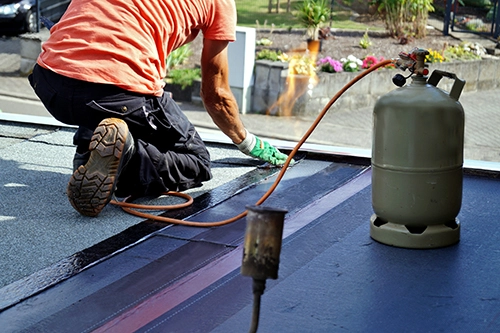- About Us
- Services
- Blog
- Contact
Need a quote?
Before the sunny days well and truly come to an end, you should find time to get up on your roof and inspect it before the winter starts, to see if you need a replacement roof installed. Giving it a quick look over, and keeping an eye out for these four tell-tale signs, could save you a lot of money in the long run.




Damp areas or leaks may indicate that there is a cracked/ slipped/ worn roof tile, which will require the help of an expert to fix, as quickly as possible. If there are a great number of broken tiles, this may suggest the whole roof will need replacing.
Exposure to the elements can impact the functionality of your roof, as the boards will start to buckle and break under the weight of sitting water. In turn, this causes the roof to sag, which can affect the interior of your home as it quickly becomes dangerous and unsafe to live in. If you have a flat roof that is sagging, you should seek out a roof repair company as quickly as possible.
You should also try to examine your roof from the inside, if you are in your loft and you notice daylight filtering through, this is a very bad sign, and you should hire a roofing company as quickly as possible. Gaps in the roof can let water in which can further damage the inside of your home.
Roofing companies generally recommend a roof replacement every 20 - 25 years, depending on initial installation and upkeep. If your roof is reaching the 20-year mark, you should contact a roofing company and ask them to take a look at it to see how much life it has left in it.
If your roof is in need of some TLC, our roofing company will be more than happy to visit and conduct a survey so we can tell you the best course of action. Just get in touch to arrange a visit.
It depends on the construction, but the minimum weight a flat roof must be capable of bearing is 300lbs. This refers to a concentrated weight where a load is positioned on just one area of the roof. So, for example, a commercial flat roof can approximately support a 300lb HVAC unit in a 2.5×2.5ft single space.
If you opt for a flat roof anywhere on your property, remember that it comes with a need for proper maintenance. Low-slope roofing London-wide should be checked every six months or so, or after spells of bad weather, to spot any signs of damage. No matter how small, these should be addressed before they escalate. Remove any debris (leaves, twigs and so on) regularly to avoid these blocking the gutters and allowing water to pool and stand on the roof.
If there are trees in the close vicinity, keep them cut back to reduce the amount of foliage that falls on your flat roof. And check internally for signs of moisture, dampness or water damage on a regular basis. Spotting problems early means resolving them will be cheaper in the long run.

Building a flat roof can be done in three ways. The simplest and most cost-effective choice for levelled roofing London-wide is to construct a warm roof where a roofing membrane is placed over the insulation that keeps the timber structure warm. Another option is to create a cold roof where insulation is positioned between the rafters under the ply roof covering. This is commonly applied to flat-roofed extensions.
The third method is the hybrid roof that contains diverse elements. Their designs require a gap of ventilation above a warm roof to prevent excess moisture within the roof structure.
If you’re looking for flat roofing local contractors, don’t just select the first firm you come across. Find a roofing company that’s been in business for a while and can demonstrate a good track record in installing, repairing, and replacing flat roofs specifically. Ask for recommendations from your own network or from a local trade association. If you need refurbishment work done to 50% or more of your roof, you’ll need a roofing contractor who can self-certify their work under the Competent Person Scheme. Otherwise, the Building Control department at your local authority will need to approve the job before it begins.
Ask whether they are covered by liability insurance and how long they’ll guarantee the work they will carry out. And never just opt for the cheapest quote unless you’re quite sure they’re the best company for the job. You can’t afford to compromise on your roof as the structural integrity of your property depends on it.
Ensuring your flat roof will comply with building regulations before installation can save property owners time, money and stress. First, the roof must have a slope of around 1:80, with water draining away to one or two roof edges. Waterproofing must be extended up to the adjacent walls with at least 150 mm from the surface of the roof.
Contractors must install ventilation in cold roofs. For warm roofs, the deck must be bonded with a VCL. The roof should have the capacity to withstand strong winds and be sturdy enough to take an individual’s weight. Finally, check whether planning permission is needed. Typically, this is only required if you live in a conservation area or a listed building, or are making significant changes to an existing roof.
If you’re looking for top roofing solutions at competitive rates, check out our range of roofing services at Environ Roofing Company London. To get started, call one of our representatives today!

